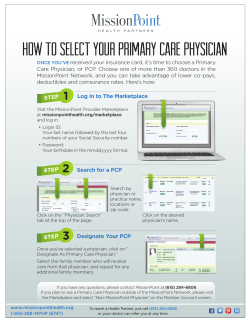
Cincinnati-Dayton - Bricker & Eckler LLP
Health Care Reform Express Health Care Reform Bulletin No. 9 June 2010 Bricker & Eckler LLP 100 South Third Street Columbus, Ohio 43215-4291 Phone 614 . 227 . 2300 Fax 614 . 227 . 2390 info@bricker.com www.bricker.com COLUMBUS CLEVELAND CINCINNATI-DAYTON Health Care Reform Task Force Health Care Michael K. Gire 614 . 227 . 2318 mgire@bricker.com David M. Johnston 614 . 227 . 8817 djohnston@bricker.com Karen D. Smith 614 . 227 . 2313 ksmith@bricker.com Insurance Miranda C. Motter 614 . 227 . 4810 mmotter@bricker.com Elisabeth A. Squeglia 614 . 227 . 2396 esqueglia@bricker.com Faith M. Williams 614 . 227 . 2374 fwilliams@bricker.com Employment James G. Petrie 614 . 227 . 2373 jpetrie@bricker.com EmployEE BENEFITS Christine M. Poth 614 . 227 . 2395 cpoth@bricker.com tAX Meredith K. Knueve 614 . 227 . 4886 mknueve@bricker.com EDUCATION Melissa M. Carleton 614 . 227 . 4846 mcarleton@bricker.com Nicholas A. Pittner 614 . 227 . 8815 npittner@bricker.com The Health Care Reform Law Includes Key Stark Law Changes O n March 23, 2010 President Obama signed into law the highly anticipated Patient Protection and Affordable Care Act (PPACA)(H.R. 3590, Pub L 111-148), which was amended shortly thereafter on March 30, 2010 by the Reconciliation Bill (H.R. 4872, Pub L 111-152) (together, PPACA). As discussed further below, PPACA contains several significant provisions affecting the Stark law (42 USC 1395nn), including a new Stark law self-disclosure protocol, restrictions on physician-owned hospitals, and requirements for transparency in physician-owned imaging services. HHS to Create Stark Law Self-Disclosure Protocol with Compromise Authority Among the PPACA’s most positive developments is that Section 6409 requires the Secretary, in cooperation with the Department of Health and Human Services (HHS) Office of Inspector General (the OIG), to develop and implement by September 23, 2010 a protocol for health care providers and suppliers to disclose actual or potential violations of the Stark law (the Stark SRDP). The need for a Stark law self-disclosure process became more critical a year ago when the OIG announced it would no longer accept self-disclosures involving violations of the Stark law under its protocol, unless the self-disclosure also included a colorable anti-kickback statute violation. Following the OIG’s March 2009 announcement, providers and suppliers were left with no clear options regarding how and where to disclose a Stark-only violation. Another concern was that the Centers for Medicare and Medicaid Services (CMS) was bound by law to impose the full amount of the Stark law penalties, and therefore, could not reduce or compromise the penalties for Stark law violations. Under the Stark law, violators must repay CMS all of the reimbursement received for services referred by a physician involved in a noncompliant arrangement, regardless of the violator’s intent. This overpayment liability can quickly add up to extraordinary sums, and is often based on mere technical Stark law violations, such as missing signatures or expired contracts. Because Stark law penalties are so often disproportionately high in light of the nature of the violation, many industry stakeholders felt that CMS needed to create a fair and reasonable process to settle Stark law violations, with the potential for reduced penalties. In response to this concern, PPACA expressly authorizes the Secretary to reduce the amounts due for Stark law violations to an amount less than the full penalties, and to consider: i) the nature and extent of the improper or illegal practice; ii) the timeliness of the self-disclosure; iii) the provider or supplier’s level of cooperation in providing additional information; and iv) other factors that the Secretary may determine in its discretion. In addition, the Stark SRDP must identify a specific person, official, or office to whom providers and suppliers can make disclosures, and explain the effect of self-disclosures on corporate integrity agreements and corporate compliance agreements. The Secretary must also post information about how to use the Stark SRDP on the CMS website and HHS is required to report to Congress within 18 months after the Stark SRDP is established on its effectiveness. PPACA clarifies that the Stark SRDP will be separate from the already existing Stark law Advisory Opinion process under which parties can write to CMS asking for an opinion about whether a specific arrangement complies with the Stark law. April 2010 Health Care Reform Express In connection with the Stark SRDP, health care providers and suppliers should also be aware of changes in Section 6402 requiring repayment of overpayments to the government within 60 days of the date the overpayment is “identified.” Although several important aspects of the 60-day refund obligation remain uncertain, such as a clear definition of what constitutes an “identified overpayment,” providers and suppliers should begin taking steps to incorporate audit and refund processes into their compliance efforts. Future CMS regulations should clarify application of this rule, including possible tolling of the 60-day period, or other effects on the 60-day repayment obligation of using the Stark SRDP. No New, and Restrictions On Existing, Physician-Owned Hospitals After years of reconsidering the Stark law “whole hospital” exception, PPACA has finally prohibited physicians from ownership in new hospitals to which they will refer altogether. (The Stark “whole hospital” exception allows a referring physician to own an interest in an entire hospital if the physician is authorized to perform services at the hospital.) Specifically, Section 6001 prohibits physician ownership in a hospital that does not have a Medicare provider agreement as of December 31, 2010. As a concession to existing physician-owned hospitals, PPACA grandfathers physician-owned hospitals with Medicare provider agreements in place by December 31, 2010, thereby allowing physicians to keep their ownership in existing hospitals. However, PPACA will make changing pre-existing physician-owned hospitals more difficult by restricting increases in the percentage of total value of physician ownership and investment interests in physician-owned hospitals from the amounts held as of March 23, 2010 and restricting increases in operating rooms, and procedure rooms. A limited exception to this restriction allows growth for physician-owned hospitals that treat the highest percentage of Medicaid patients in their counties. In a move toward greater transparency, PPACA requires both referring and treating physician-owners in these hospitals to disclose their ownership in the hospital to patients in time for patients to make a meaningful choice about their hospital care. Section 6001 also requires a written annual report to CMS identifying the owners and extent of ownership; reported information will be posted on the CMS website. Similarly, the hospital must identify physician ownership in any advertising and on the hospital’s website. Lastly, new patient safety provisions require physician-owned hospitals to disclose to patients prior to their admission any period of time when the hospital does not have a physician on the premises and to obtain a signed acknowledgement from the patient. Physician-owned hospitals must also have the capability to assess and provide initial treatment for patients, and to refer and transfer patients to appropriate facilities. CMS is required to issue regulations providing further guidance on these changes by January 1, 2012. Transparency in Physician Ownership of Imaging DHS Required This document has been prepared as a general reference document for informational purposes. The information contained herein is not intended to be and should not be construed as legal advice. Each circumstance should be considered and evaluated separately, and possibly with involvement of legal counsel. Please contact Bricker & Eckler for permission to reprint this bulletin in part, or in its entirety. Page 2 In Section 6003 PPACA incorporates a new transparency requirement for physician ownership of certain ancillary services effective January 1, 2010. In particular, PPACA amends the Stark law in-office ancillary services exception to require physicians referring patients for in-office MRI, CT, PET, or other radiology services that the Secretary of HHS may deem appropriate, to inform patients, in writing, at the time of their referral that i) the physician has an ownership interest in the imaging or other service provider to which the physician has referred the patient, and ii) the patient has the option to obtain the services from a person other than the referring physician, a physician member of the same group practice as the referring physician, or someone directly supervised by the referring physician or another physician in the group practice. Section 6003 also requires the referring physician to provide the patient with a list of alternative suppliers in the area where the patient resides. Numerous questions regarding implementation of these requirements remain, including how many alternatives a physician must list and how to identify the geographic area where the patient resides. Despite these lingering questions, physicians relying on the in-office ancillary services exception should take steps immediately to develop and issue patient notices using a good faith interpretation. Further regulations required by PPACA should clarify these issues in the future. Although PPACA states that Section 6003 was effective January 1, 2010, enforcement for services prior to PPACA’s enactment on March 23, 2010 is unlikely. This Bulletin was prepared by Claire Turcotte with assistance of Shannon DeBra and Bryn Beers. Please contact Claire Turcotte at 513.870.6573/cturcotte@bricker.com or Shannon DeBra at 513.870.6685/sdebra@ bricker.com, or any member of the Health Care Practice Group for further information. The Bricker & Eckler Health Care Reform web site can be accessed at www.bricker.com/reform.
© Copyright 2025









